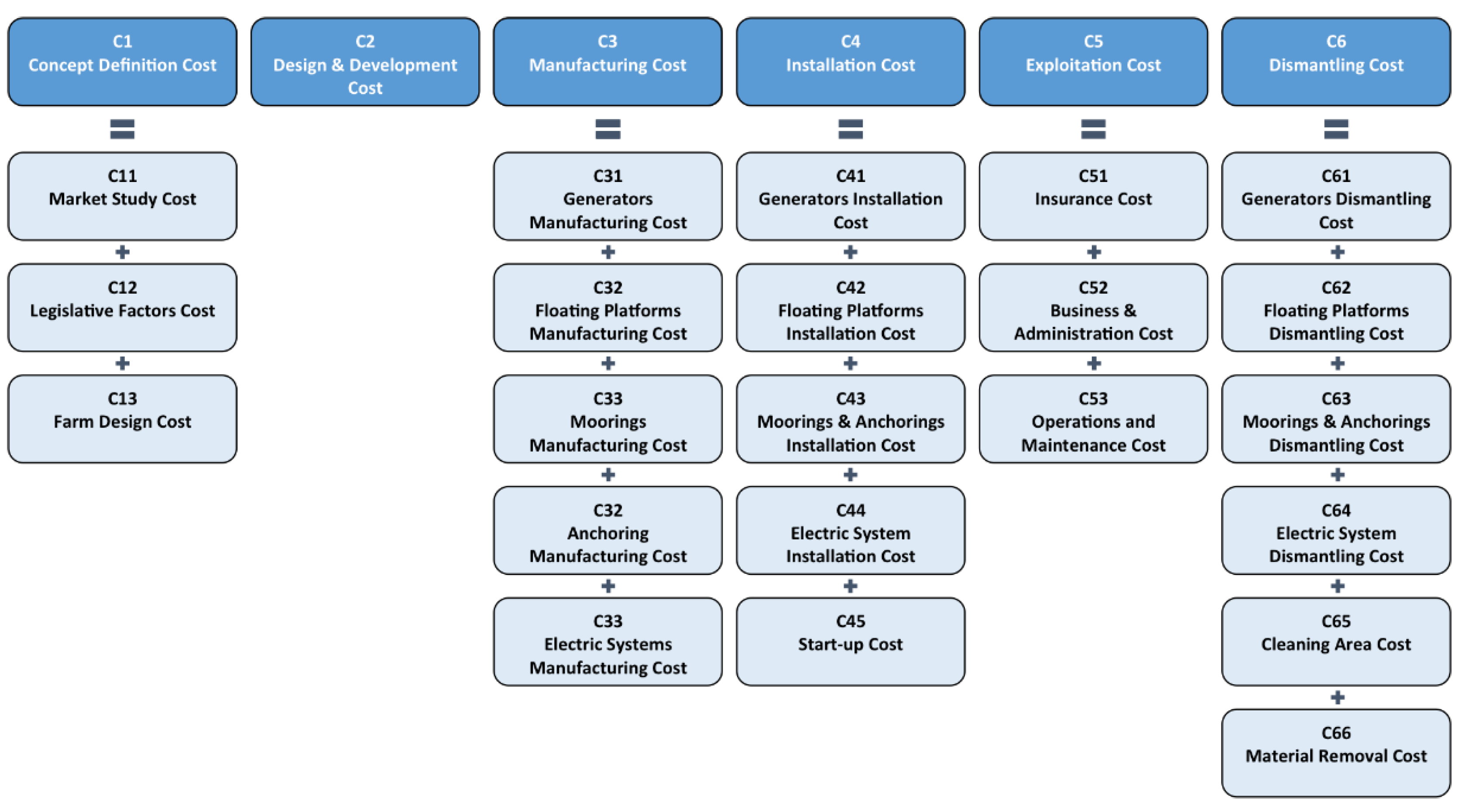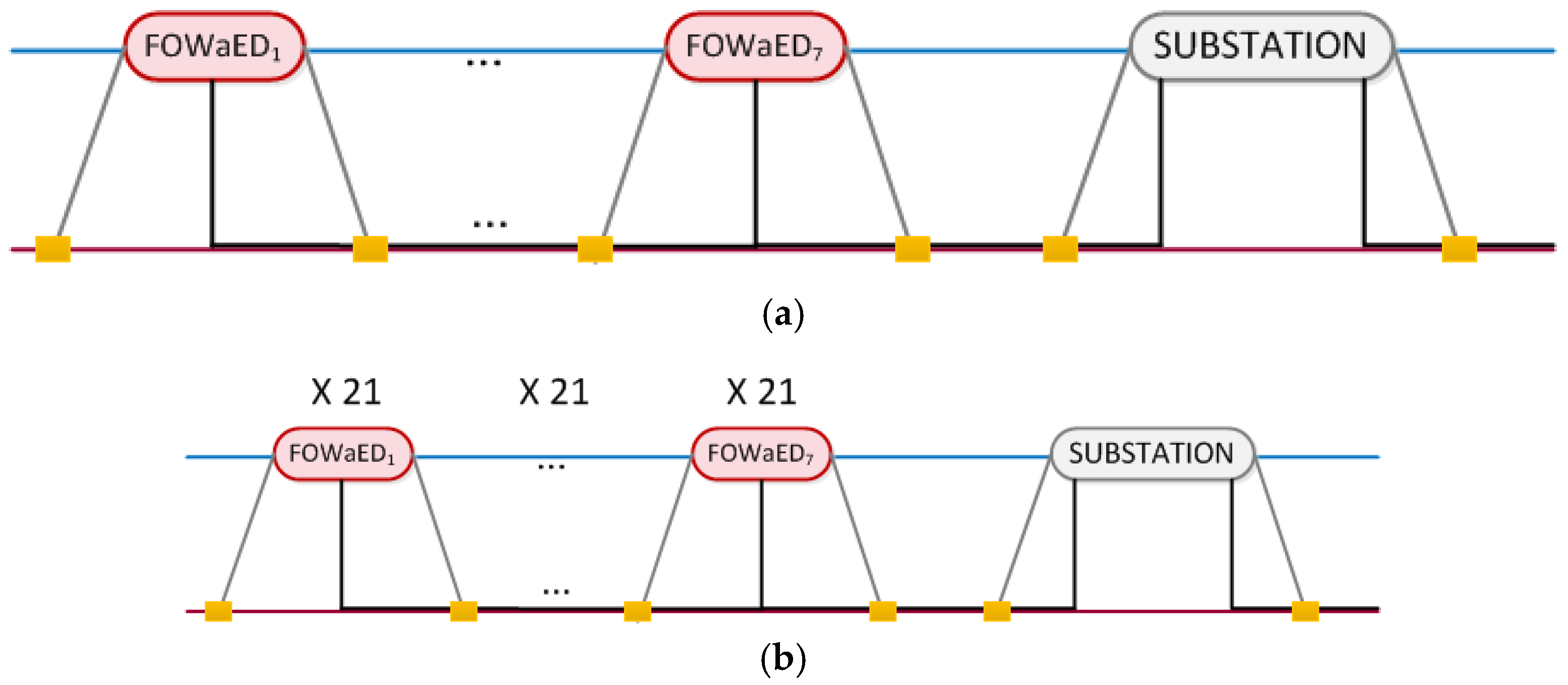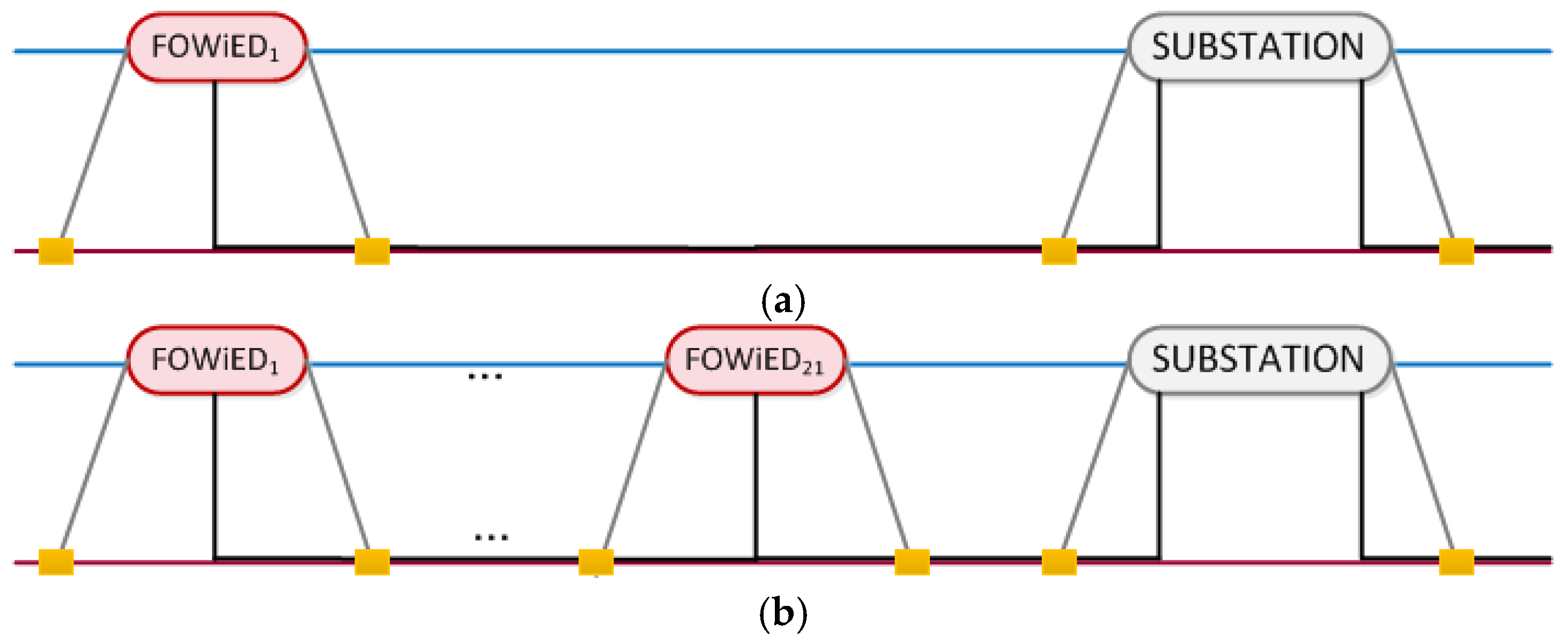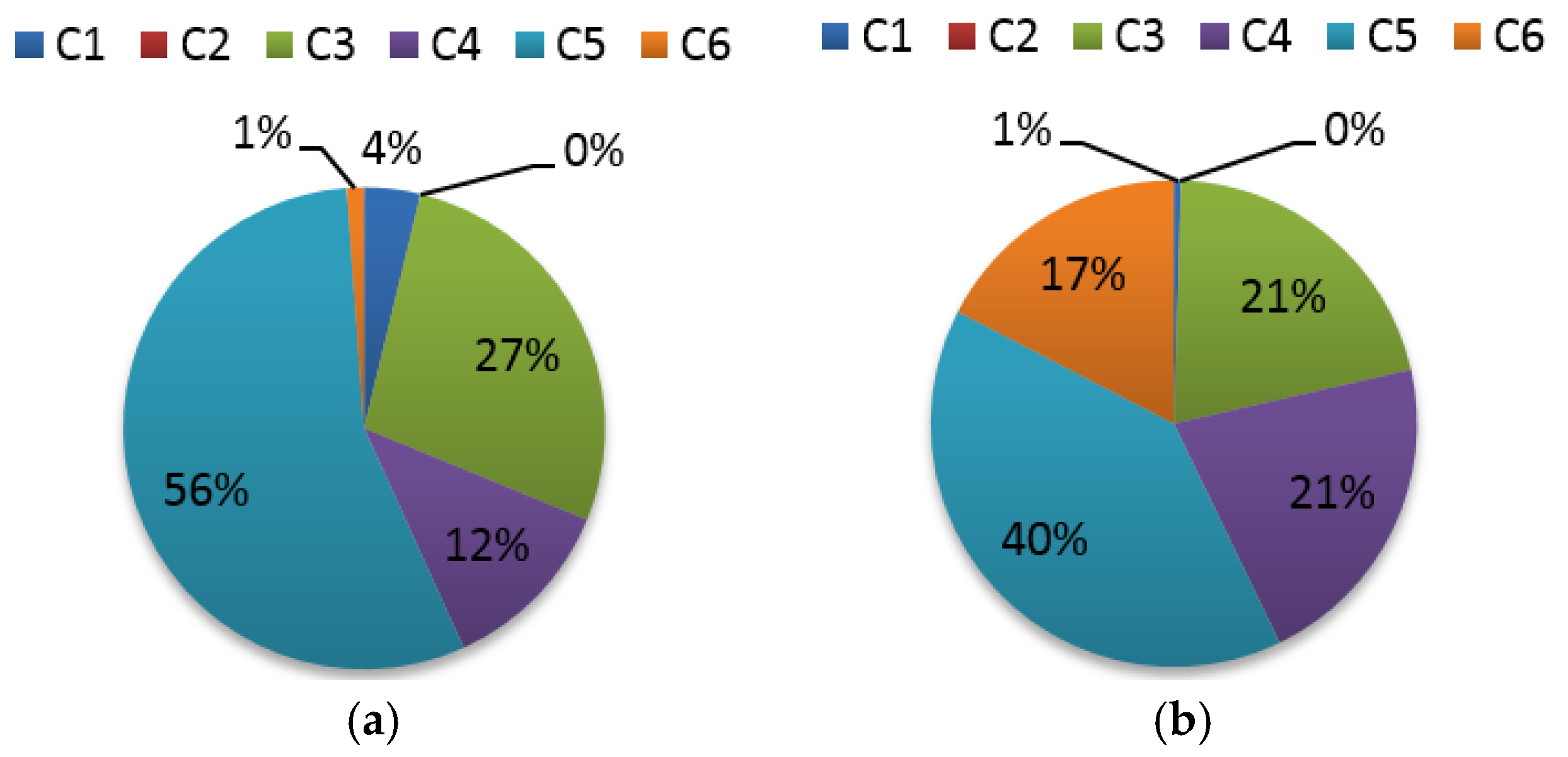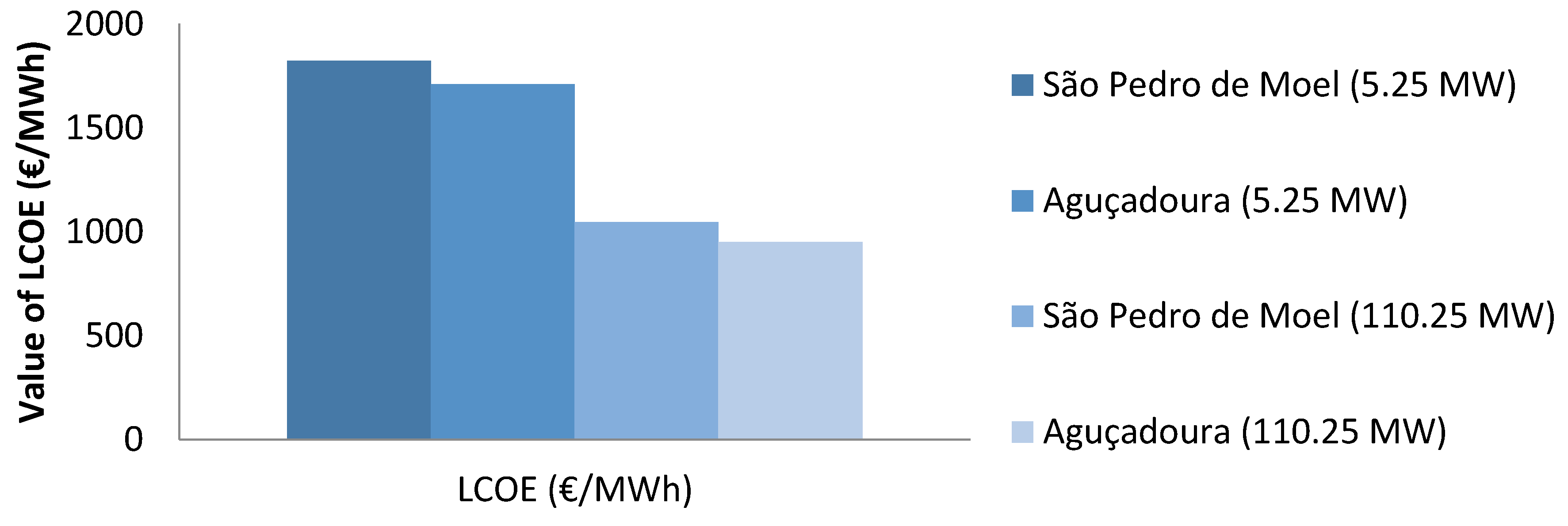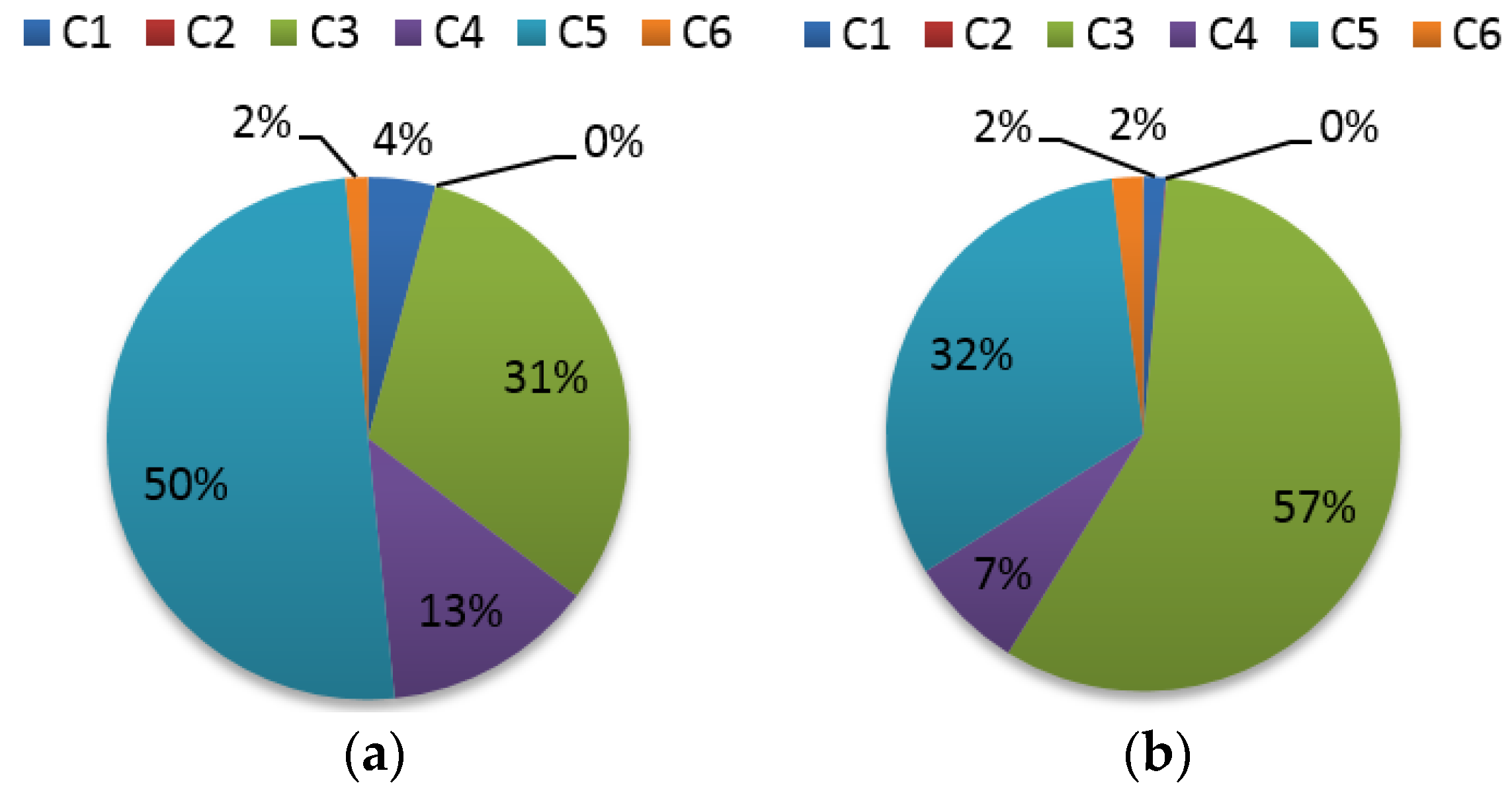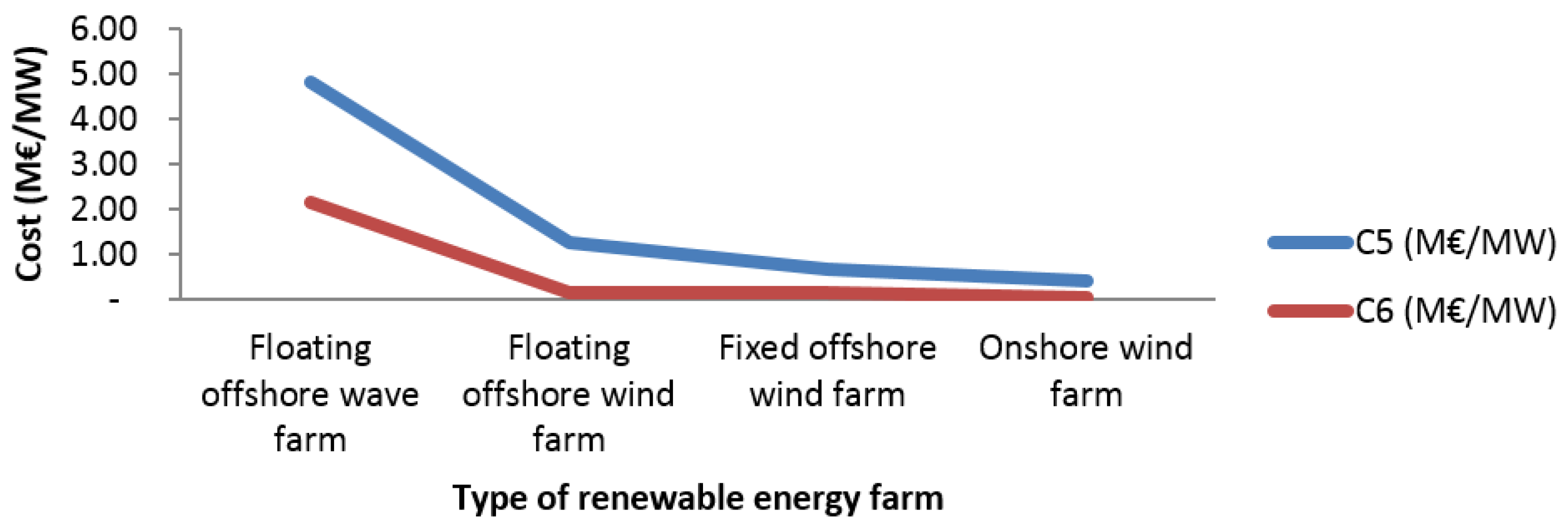2.1. General View
The methodology proposed has been adapted from the floating offshore wind [
24] and wave [
25] life-cycle process and it is based on the life-cycle of floating offshore renewable energy devices (FOWEDs), which is composed by six main phases (
Figure 1): concept definition, design and development, manufacturing, installation, exploitation and dismantling.
The costs of these phases comprise the Life-cycle Cost System (LCS) of a floating offshore renewable energy farm (FOREF), as follows:
where
C1 is the cost of concept definition,
C2 is the cost of design and development,
C3 is the cost of manufacturing,
C4 is the cost of installation,
C5 is the cost of exploitation and
C6 is the cost of dismantling.
C5 is the overall exploitation cost for the number of years that the farm is active, whereas in most paper reports it is shown as an annual cost. These costs are studied in order to develop a methodology to calculate the total cost, in €, and the Levelized Cost of Energy (LCOE), in €/MWh, of the FOWEDs.
The costs are built up from their various components denoted as sub-costs (
Figure 2) so as to reflect the details of the configuration on the final cost. The next sections are focused on this issue.
2.2. Concept Definition Cost
The cost of concept definition considers all the preliminary studies to develop the offshore renewable energy farm as, for instance, the offshore energy resource spatial and temporal distribution to know which location will be the most appropriate to install the offshore farm and the economic feasibility of the project, among others.
In this context, three sub-costs have been defined: market study (
C11), legislative factors c (
C12) and farm design (
C13), as shown:
The market study cost will take into account the preliminary feasibility study to know if the farm and its location will be feasible:
The legislative factors cost is dependent on the taxes of the country selected to install the floating offshore renewable energy farm, as shown:
Finally, one of the most important issues in terms of installing a floating offshore renewable energy farm is to know what the location is. In this sense, the offshore energy resource available, the sea conditions (
) and the geotechnical characteristics of the seabed (
) should be studied. Therefore, their costs are as shown:
This cost is dependent on the number of offshore renewable energy devices (NA) and their power per unit (PA), in MW.
2.4. Manufacturing Cost
The manufacturing cost considers the costs of fabricating the device generators (
C31), floating platforms (
C32), moorings (
C33), anchoring (
C34) and electric systems (
C35), the main components of a farm are as shown:
The manufacturing cost of generators is mainly dependent on the cost (€/MW) of each generator (
CMW). Furthermore, this value is multiplied by the power per unit (
PA), in MW, and the number of floating offshore renewable energy devices (
NA):
The floating platform manufacturing cost is divided in two main costs: the basic floating platform, which also depends on the number of floating offshore renewable energy devices (
NA), and the substation floating platform, which also depends on the number of floating platforms for the substation (
Psub
):
The cost of manufacturing the floating platforms for generators (
) has been calculated considering an Activity-Based Cost (ABC) model in a conventional shipyard [
26], where these types of floating platforms are built. The cost comprises the materials costs (
CMAT), the direct labour cost (
CDL), the activity cost (
CACT) and the industrial profit (
Bi), as shown:
The cost of materials, direct labour and activities will be different depending on the floating offshore renewable energy platform considered, because the quantity of steel changes.
The cost of direct labour is dependent on the mass of the platform (
mplatform), the live surface of the platform (
Sov), the died surface of the platform (
Som), the interior surface of the platform (
Si) and the cost per hour (€/h) of the direct labour (
Cmo):
The cost of materials is also dependent on the mass of the platform (
mplatform), the live surface of the platform (
Sov), the dead surface of the platform (
Som), the interior surface of the platform (
Si) and the cost of steel in €/ton (
Csteel):
The cost of the activities is dependent on the direct labour cost (
CDL), the materials cost (
CMAT) and the mass of the platform (
mplatform), namely because of aspects such as the electricity consumption and others:
The cost of manufacturing the floating platform of the substation (
) has been considered as a constant value [
26].
The cost of manufacturing the mooring comprises the cost of manufacturing the mooring of the device platform (
C331) and the cost of manufacturing the mooring of the substation platform (
C332), as shown:
The cost of manufacturing the mooring of the device platform is dependent on the mass per meter (kg/m) (
pMOOR) of the mooring, the length of the mooring in m (
LMOOR), the cost of the mooring in €/kg (
CMOOR), the number of mooring lines (
LP) and the number of generators (
NA):
The cost of manufacturing the mooring of the substation platform is zero because it is included here in the cost of manufacturing its floating platform.
Similarly, cost of manufacturing the anchoring comprises the cost of manufacturing the anchoring of the device platform (
C341) and the cost of manufacturing the anchoring of the substation platform (
C342):
The cost of manufacturing the anchoring of the device platform is dependent on the cost of the mass of the anchor in kg (
mANC), the anchoring in €/kg (
CANC) for a drag embedment anchor, the number of mooring lines (
LP) and the number of generators (
NA):
Just like in the case of the moorings, the cost of the anchoring for the substation platform is zero because it is included here in the cost of manufacturing its floating platform.
The cost of manufacturing the electric system refers to the electric cables (
C351) and the substation (
C352), as shown:
The cost of manufacturing the electric cable is dependent on the number of generators (
NA), the number of electric cables (
Nx), the length of the electric cable in m (
dx) and the cost in €/m of the electric cable (
Cx) (
Figure 3), as shown:
where:
| Area | Nx | dx | Px |
| WIND | WAVES |
| off1a | NAF | P | 5 MW | 0.75 MW |
| off1b | 1 | NDGENERATORS × D | 5 MW | 0.75 MW
1.50 MW
2.25 MW
3.00 MW
3.75 MW
4.50 MW
5.25 MW |
| off1c | NF | P | 5 MW | 5.25 MW |
| off2 | 1 | P + d | 5 MW | 5.25 MW |
| on | 1 | donshore | 5 MW | 5.25 MW |
The cost of manufacturing the substation is calculated as in an onshore location, but taking into consideration a coefficient (
KSUBE) which makes this value higher, because the cost of an offshore substation, in terms of corrosion, is higher than the onshore one. In addition, it depends on the number of transformers (
NTS), the cost of the transformer (
CTS) and the cost of the GIS (
CGIS), as shown:
2.5. Installation Cost
The installation cost comprises the cost of installing the device generator (
C41), the floating platforms (
C42), the moorings and anchorings (
C43), and the electric system (
C44). It also includes the start-up cost (
C45), as shown:
The cost of installing the generator (
C41) is dependent on the costs related to the shipyard or port operations (
C41
pa), the costs due to its transport (
C41
transport) and the costs due to its installation (
C41
installation), as shown:
The value of the cost of port operations (
C41
pa) is dependent on the type of floating offshore renewable energy considered. In this sense, this cost is dependent on the number of generators (
NA), the distance from shipyard to port in m (
dshipyard−port), the speed of the tug in m/s (
vtug), the cost of transporting to port in €/h (
Ctransport to port), the time spent on loading the generator at port in s (
tchargeGENERATOR), the cost of the port crane in €/h (
Ccrane), the number of liftings of the generator to charge it (
NIchargeGENERATOR) and the time to lift the generator in the vessel (
TIchargeGENERATOR), as shown:
where:
For wave energy devices, the cost of the shipyard or port operations (C41pa) is zero because it is included here in the cost of installing the floating platform, since the device generator is inside the platform.
The transport cost of installing the generator is zero due to the fact that it is included in the cost of installing the floating platform. The main reason for this issue is the fact that the installation process will take part in towing the floating platform. Therefore, the transportation of the generator is simultaneous to the transportation of the floating platform.
The installation cost of the generators, for the case of the floating offshore wind energy, is dependent on the number of generators (
NA), the time spent on loading the generator at port in s (
tchargeGENERATOR) and the cost of the port crane in €/h (
Ccrane), as shown:
However, for wave energy devices, the cost of installing the device generators () is included in the cost of installing the floating platform, hence its value here is zero.
On the other hand, the cost of installing the floating platforms is also composed of three main sub-costs, as equation shows: operations at port or shipyard (
), transport of the platforms (
) and installation of the platform (
):
The cost related to the operations at port or shipyard depends on the number of generators (
NA), the distance from shipyard to port in m (
), the speed of the tug in m/s (
), the cost of transporting the platform to port in €/h (
), the time spent on hiring the installations of the shipyard or the port to storage the platforms in s (
), the area of storage in m2 (
), the cost of store in (
), the time spent on loading the platform at port in s (
) and the cost of the port crane in €/h (
):
The cost of transporting the floating platforms is calculated depending on the number of vessels considered (
), the number of platforms (
), the coefficient TA1 calculated before, the cost of the vessel taken into account in €/day (
) and the cost of moving the vessel in € (
):
The cost of installing the floating platforms is dependent on the number of vessels used to install the platform (
), the time of installing the platform (
), the number of platforms (
) and the cost of the crane in the shipyard (
), as shown:
Regarding the cost of installing the mooring and anchoring (
C43) a methodology considering an Anchor Handling Vehicle, which is specialized in this field, has been considered [
27]. This type of installation does not need submersed equipment, which reduces cost. The value of this cost is calculated as a function of the cost of the vessel in €/day (
), the cost of its direct labour in €/day (
), the cost of pumps and divers in €/day (
), the number of anchors (
), the time spent on installing using an AHV in anchors/day (
), as shown:
where the number of anchors (
) is dependent on the number of device generators (
NA), the number of mooring lines per platform (
LP), the number of substation platforms (
) and the number of mooring lines per substation (
):
The cost of installing the electric system (
C44) is composed of two main aspects: the cost of installing the electric cable (
) and the cost of installing the substation (
):
The cost of installing the electric cable is calculated depending on the cost of installing the 20 kV electric cable in €/day (
), the coefficient of installing the 20 kV electric cable in m/day (
), the number of lines of devices (
NF), the cost of installing the 220 kV electric cable in €/day (
), the coefficient of installing the 220 kV electric cable in m/day (
), the cost of onshore electric cable installation in €/m (
), the number of electric cables (
) and the length in m of the electric cables (
), as shown:
On the other hand, the calculation of the cost of installing the substation (
) is dependent on costs of port (
), transport (
) and installation (
). Its calculus is analog to the floating platform installation process:
where:
Finally, the start-up cost is calculated as follows:
2.6. Exploitation Cost
The exploitation cost (
C5) is composed of several sub-costs: the insurance (
C51), the business & administration (
C52) and the operation and maintenance (
C53), as shown:
The insurance cost is considered here as a percentage of the sum of the costs of the previous phases—concept definition, design and development, manufacturing and installation [
28]:
The business and administration cost is composed of the number of years of the life-cycle of the farm (
), the cost per year of the administration of the farm (
) and the cost per year of the legal aspects (
), as shown:
The operation and maintenance cost is calculated taking into consideration two aspects [
29,
30,
31]: the preventive maintenance cost per year (
C531), the corrective maintenance cost per year (
C532) and the number of years of the life-cycle of the farm (
), as shown:
The preventive maintenance cost includes activities such as periodic equipment inspection, oil and filters changes, calibration and adjustment of sensors, equipment substitution or cleaning. The specific tasks related to the preventive maintenance are considered in the specific brochure of each equipment manufacturer. Its value can be determined taking into account: the cost of transportation (
), the cost of materials (
) and the cost of direct labour (
). The cost of materials and direct labour are calculated for each of the main components involved: device (
p = 1), floating platform (
p = 2), mooring (
p = 3), anchoring (
p = 4) and electric system (
p = 5). However, the cost of transportation is considered only once here, because it is assumed that the trip of the vessel will be the same for all the components. Furthermore, it is necessary to say that the preventive maintenance will take place in summer because it is the season when the weather conditions are better. Therefore, the costs will be reduced.
The cost of transportation for preventive maintenance is calculated taking into account: the time needed to go from the port to the farm (
), the time considered in the farm to carry out the tasks (
) and the daily cost of the transport for preventive maintenance in €/day (
):
being the various components of time dependent, among others, on the speed of the maintenance vessel in m/s (
):
The cost of direct labour for preventive maintenance depends on the type of component considered, as shown:
| DEVICE (GENERATOR) | | (50) |
| FLOATING PLATFORM | | (51) |
| MOORING | | (52) |
| ANCHORING | | (53) |
| ELECTRIC SYSTEM | | (54) |
The preventive maintenance of the generator includes visual reviews, cleaning, calibration, lubrication, etc. of its main components. is the number of people, is the required time in h/generator and is the cost of the direct labour for preventive maintenance in €/h ().
The preventive maintenance of the floating platform also includes visual inspections, cleaning, etc. is the number of persons, is the required time in h/platform and is the cost of the direct labour for preventive maintenance in €/h ().
The preventive maintenance of mooring also includes visual reviews, cleaning, etc. is the number of people, is the required time in h/mooring and is the cost of the direct labour for preventive maintenance in €/h (). The reviews will take place in the submersed area. Therefore, divers will be used for these tasks. Then, the cost will be similar to the platform cost.
The material cost of the preventive maintenance is dependent on the cost of the direct labour (
) and the cost of the transport (
) [
28], as shown:
The corrective maintenance is not programmed, taking place after the occurrence of a failure. Its cost is composed of the cost of direct labour (
), the cost of transportation (
), the cost of materials (
) and the failure probability of the component “p” (
) [
29], as shown:
The corrective maintenance cost for the generator (
p = 1) is dependent on the probability of failure of each component c1 of the generator (
), the cost of direct labour (
), the cost of transport (
) and the cost of materials (
) for each of these components, as shown:
The number of components considered depends on the type of technology, which is dependent on the offshore renewable energy (see
Table 1):
The corrective cost for the floating platform is calculated considering the failure probability of the floating platform (
), the probability of using crane in the corrective maintenance (
), the probability of not using crane in the corrective maintenance (
) and the coefficient due to the accommodation of the direct labour (
):
where:
The corrective cost for the mooring is dependent on the cost of direct labour (
), the cost of transport (
), the cost of materials (
), the failure probability of the mooring (
), the number of devices (
) and the number of mooring lines per generator (
), as shown:
where:
The corrective cost for the anchoring, the calculation of which is very similar to the mooring cost, is dependent on the cost of direct labour (
), the cost of transport (
), the cost of materials (
), the failure probability of the mooring (
) [
32], the number of devices (
NA) and the number of mooring lines per generator (
LP), as shown:
where:
The corrective cost of the electric system is dependent on the number of transformers (
), the probability of failure of the transformers (
), the cost of the corrective maintenance of the transformers (
), the parameter of the substation (
), the number of electric cables (
), the probability of failure of the electric cables (
) and the cost of the corrective maintenance of the electric cable (
), as shown:
2.7. Dismantling Cost
The floating offshore renewable energy farm should be dismantled at the end of operational life in order to clean the area and leave it as initially. Firstly, the farm is disassembled and, then, the main materials obtained (steel, copper,
etc.) can be sold. This income will be considered as a negative cost. Here, the dismantling cost is dependent on the cost of dismantling device generators (
C61), the floating platforms (
C62), the mooring and anchoring systems (
C63) and the electric system (
C64). It also includes the cleaning cost of the area (
C65) and the removal cost of the materials (
C66), as shown:
The dismantling method of the device generators is the same as in the case of the installation process. However, in this case the time will be less, because less caution is necessary in the process. In this sense, the cost of dismantling the device generators is dependent on the cost of the offshore dismantling of the device (
), the cost of its transport from the farm to the port (
) and the cost of the process at port (
), as shown:
Here it is considered that the device generator is towed simultaneously with the floating platform. For this reason
and
are zero. The cost of the process at port is as shown:
The cost of dismantling the floating platforms is also dependent on the cost of the offshore dismantling of the platform (
), the cost of its transport from the farm to the port (
) and the cost of the process at port (
), as shown:
In this case, the offshore dismantling cost of the platform is zero, because it is dismantled onshore. The cost of the transport in terms of dismantling is the same as in the case of the installation process,
i.e.,:
The cost due to the operations at port for the floating platform is calculated as follows:
The cost of dismantling the mooring and anchoring systems is similar to their installation cost, but considering less time for the operations (
):
The cost of dismantling the electric system is composed of two main components: the cost of dismantling the electric cables (
) and the cost of dismantling the offshore substation (
):
The requirements of the vessels for the dismantling of the electric cables are less strict than the installation process. Therefore, its cost will also be inferior. In this case, tugs, cargo barges and OSV have been considered. The electric cable is cut in portions. In this context, the cost of dismantling the electric cable is dependent on the cost of the barge for dismantling the cable in €/day (
), the cost of the OSV vessel for dismantling the electric cable in €/day (
), the cost of the dredge for dismantling the electric cable in €/day (
), the dismantling coefficient of the 20 kV electric cable in €/m (
), the dismantling coefficient of the 220 kV electric cable in €/m (
), the cost of installing the onshore electric cable (
), the number of electric cables (
) and the length in m of each electric cable (
), as shown:
The cost of dismantling the offshore substation is dependent on the number of substations (
), the cost of dismantling the substation (
), the cost of transporting the substation (
) and the cost of dismantling the substation at port (
), as shown:
where:
Cleaning the area is carried out considering the methodology taken into account in the offshore oil industry, which considers the total surface of the farm. In this sense, the cost of the cleaning area is dependent on the cost of cleaning the surface occupied by the farm in €/m
2 (
), the number of lines (
NF), the number of diameters per line (
), the diameter of the generator (
D), the number of devices per line (
NAF) and the number of diameters between devices (
), as shown:
Finally, the cost of the disposal of the materials is composed of the cost of its processing (
), transportation (
) and elimination (
) (income if it is sold as scrap or cost if it is taken to a dump):
Considering the elimination, some of the components will be sold as scrap whereas the rest will be disposed of a dump, as
Table 2 and
Table 3 show.
The processing cost is determined considering each of the components of the floating offshore renewable energy farm. It depends on the length of processing of each of the components (
) and the cost of processing in €/m of them (
):
The cost of the transport for disposal is also dependent on the component of the farm considered [
33]:
where:
| DEVICE GENERATOR (WIND) | | (84) |
| DEVICE GENERATOR (WAVE) | | (85) |
| MOORING & ANCHORING | | (86) |
| CABLES | | (87) |
| SUBSTATION | | (88) |
| PLATFORM | | (89) |
| EQUIPMENT PLATFORM | | (90) |
and:
Finally, the cost of eliminating the materials comprises the cost of eliminating each of the components,
i.e.,
where:
| DEVICE GENERATOR (WIND) | | (93) |
| DEVICE GENERATOR (WAVE) | | (94) |
| MOORING & ANCHORING | | (95) |
| CABLES | | (96) |
| SUBSTATION | | (97) |
| PLATFORM | | (98) |
| EQUIPMENT PLATFORM | | (99) |
The cost of eliminating the materials is dependent, among others, on the cost of the steel for scrap in €/kg (), the cost of the dump in €/kg () and the cost of aluminium for scrap in €/kg (). It is negative when the material can be sold, being considered as income.

